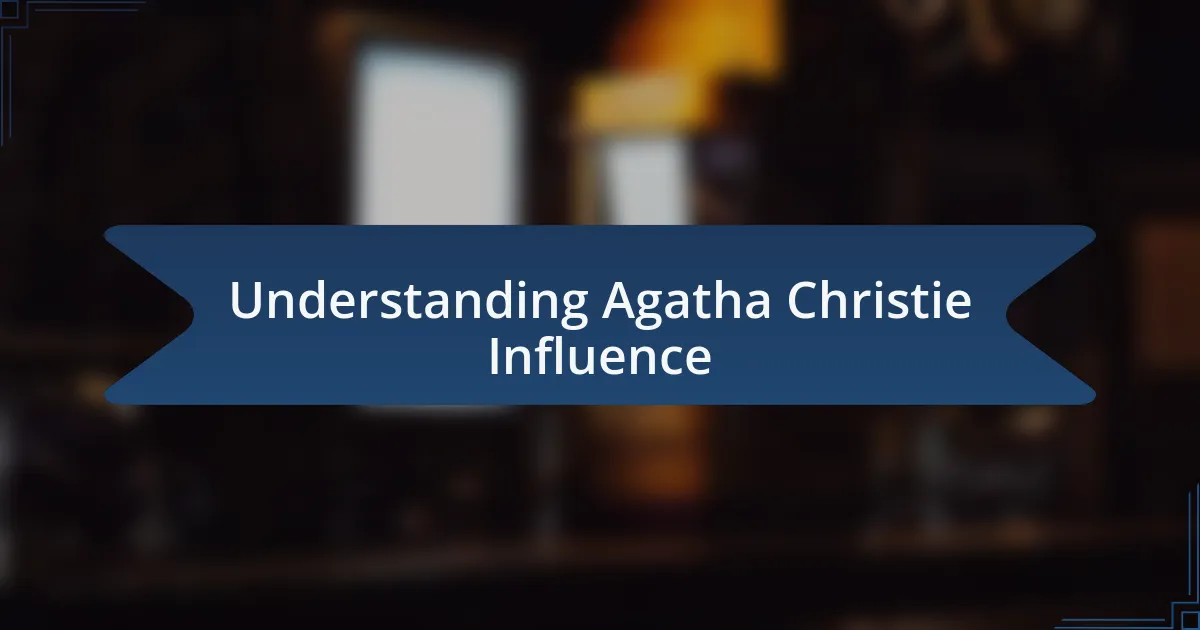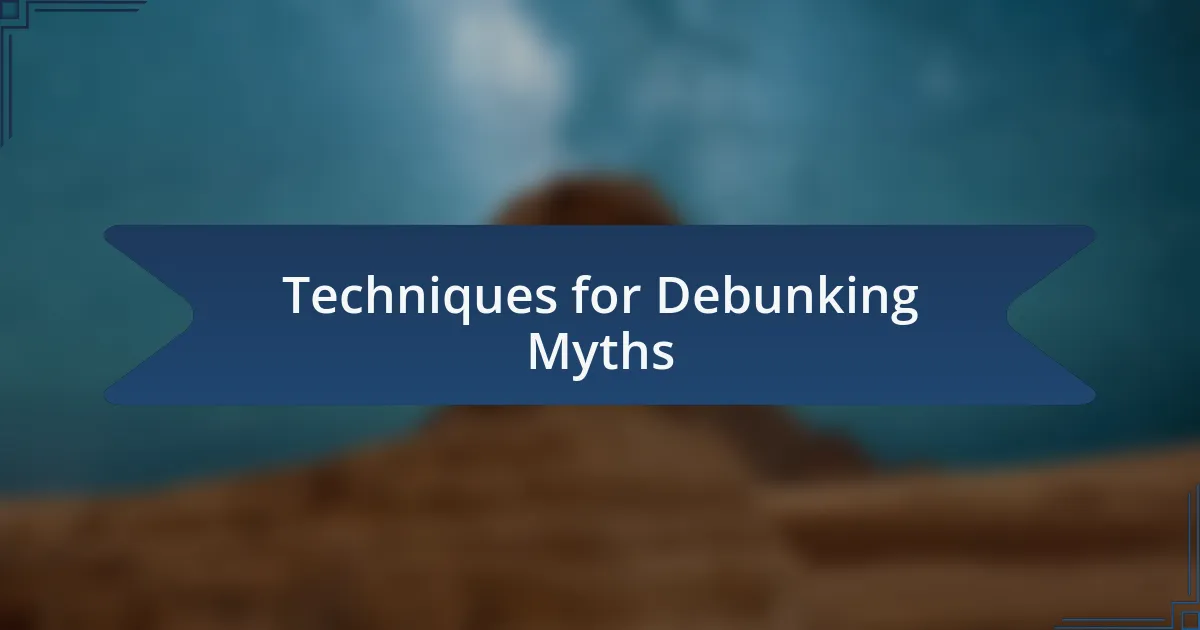Key takeaways:
- Agatha Christie profoundly influences the mystery genre through her intricate plots and complex characters, inspiring dialogue about morality and human nature.
- Common myths about Christie, such as her writing only cozy mysteries, highlight the depth and darker themes present in her works.
- Engaging with communities and sharing personal insights are effective techniques for debunking myths and enhancing understanding of Christie’s narratives.
- Christie’s characters often reflect human complexities, encouraging readers to reconsider their assumptions and appreciate the insights gained from their stories.

Understanding Agatha Christie Influence
Agatha Christie’s influence on the mystery genre is profound and often underestimated. I remember the first time I picked up one of her novels; it was as if the pages held secrets that had long been buried. Her ability to weave intricate plots keeps readers guessing until the very last page, and that’s a skill that inspires countless authors even today.
Her characters often grapple with moral dilemmas, which makes them relatable in unexpected ways. It’s fascinating to think about how Christie’s portrayal of human nature reflects our own struggles and curiosities. Have you ever found yourself rooting for the villain in a story? That complexity is what Christie masterfully encapsulated, prompting us to question our own judgments and biases.
Moreover, Christie’s impact goes beyond literature, reaching into film and television adaptations that bring her tales to life anew. I often wonder how those adaptations shape our understanding of her work. By examining these representations, we can discover how her narratives evolve and remain relevant in contemporary society. Her legacy is not just in the words she wrote, but also in the discussions they spark across generations.

Common Myths about Agatha Christie
The first common myth about Agatha Christie is that she only wrote cozy mysteries. While it’s true that her stories often feature small-town settings and amateur sleuths, many of her works dive into darker themes and complex human emotions. I recall the first time I read “And Then There Were None”; the chilling atmosphere and psychological tension was far removed from the light-hearted mysteries I initially expected.
Another myth is that Christie’s characters lack depth. In reality, her protagonists, like Hercule Poirot and Miss Marple, are layered individuals facing their own inner conflicts and dilemmas. I found myself particularly drawn to Poirot’s obsession with order; it sparked a reflection on my own desire for control in chaotic situations. Isn’t it intriguing how such fictional quirks can mirror our personal traits?
Many people also believe that Agatha Christie wrote solely for entertainment, but her narratives often reflect her acute observations of society. They raise poignant questions about morality and justice. During my readings, I frequently pondered how her observations still resonate today, urging me to think critically about the world around me. It’s no wonder her tales have withstood the test of time; they invite readers to see beyond mere entertainment and engage with deeper societal issues.

Techniques for Debunking Myths
One effective technique for debunking myths is to present evidence and facts that counter the common beliefs. For example, when I first encountered the assumption that Christie only wrote light mysteries, I dug into her darker works. This exploration unveiled stories like “Murder on the Orient Express,” which not only captivated me but also showcased her ability to intertwine moral ambiguity with suspense. Aren’t we often surprised when our preconceived notions crumble under the weight of compelling evidence?
Another approach involves personal reflection and storytelling. I remember discussing Agatha Christie with a friend who had dismissed her as just another mystery author. To change their perception, I shared my experience of reading “The Murder of Roger Ackroyd,” emphasizing how the plot twist left me both stunned and introspective. This conversation led my friend to reconsider their opinion and embrace Christie’s complex narrative style. Isn’t it amazing how sharing personal insights can reshape someone’s understanding?
Engaging with the community is also vital in the myth-debunking process. When I participated in online forums dedicated to Agatha Christie, I interacted with fellow enthusiasts who would share fascinating analyses about her characters and themes. This collective dialogue not only enriched my understanding but also encouraged others to look deeper into her narratives. How often do we find that collaboration can illuminate truths we might have overlooked on our own?

Personal Insights on Christie Works
When I first tackled Christie’s “And Then There Were None,” I was struck by her skill in crafting suspense that extends far beyond typical mystery tropes. The gradual unraveling of trust among the characters resonated deeply with me, highlighting human vulnerabilities and fears. Isn’t it fascinating how a mere story can evoke such raw emotions and provoke thoughtful introspection?
I recall my initial hesitance toward “Death on the Nile.” I almost dismissed it as just another vacation mystery, but reading it became an eye-opening experience. Christie’s portrayal of love, betrayal, and revenge amid the vivid backdrop of Egypt presented themes as timeless and profound as the pyramids. Could a mystery novel truly offer such depth? Absolutely.
Engaging with Christie’s works has often led me to explore my own assumptions. After diving into “The Body in the Library,” I found myself questioning societal norms surrounding women’s roles and appearances. The subtly woven critique within the plot made me appreciate not just the story, but also Christie’s sharp social commentary. Have you ever considered how a seemingly simple mystery can reveal complex societal issues?

My Favorite Christie Novels
There’s something utterly captivating about “Murder on the Orient Express” that keeps me coming back for more. The elegance of the setting combined with the intricate plotting envelops readers in an almost cinematic experience. Don’t you just love when a novel transports you to another place and time while challenging your perceptions of justice?
I have vivid memories of reading “The Mousetrap” for the first time; the thrilling twist left me utterly speechless. What struck me most was this sense of communal experience in a crowded theater, where every gasp magnified the suspense. Isn’t it incredible how a simple story can turn into a shared journey, pulling people together in anticipation?
Then, there’s “The ABC Murders,” where I felt a true connection to Poirot’s brilliant yet methodical crime-solving. The way Christie intertwines clues and red herrings taught me that not everything is as it seems. Reflecting on it, isn’t that a lesson we can carry into our own lives? It’s amazing how her work can resonate beyond the pages and influence our thinking about the world around us.
Lessons from Christie’s Characters
The characters created by Agatha Christie often reflect the complexities of human nature, teaching us that no one is purely good or evil. For instance, I remember how I felt conflicted while reading about the various suspects in “And Then There Were None.” My initial judgments shifted as I learned more about their backstories. Isn’t it fascinating how Christie’s characters compel us to reconsider our assumptions about morality and justice?
Take Hastings from the Poirot series, for example. His loyal yet somewhat naïve nature always made me reflect on the value of friendship over sheer cunning. There were moments while reading that I thought, could I be as steadfast in my beliefs while lacking the shrewdness to see the bigger picture? Christie’s portrayal of their dynamic reminded me that intelligence comes in many forms and that our relationships often deepen our understanding of ourselves.
Moreover, Christie’s female characters often break stereotypes, showcasing resilience and intelligence in various forms. I was particularly moved by Miss Marple, who seemed to embody the wisdom of the everyday person. The way she solves mysteries through keen observation taught me to value the insights that arise from life experiences. It makes me wonder, do we sometimes overlook the wisdom that’s right in front of us, simply because it wears a different guise?
How to Appreciate Christie’s Legacy
To truly appreciate Agatha Christie’s legacy, I believe it’s essential to immerse ourselves in the intricate plots and settings she expertly crafts. Each mystery feels like a puzzle waiting to be solved, encouraging us to think critically and engage actively with the narrative. When I first tackled “Murder on the Orient Express,” I found myself jotting down notes and theories as I unraveled the clues, which made the experience deeply personal and interactive.
Another aspect of her legacy is the exploration of themes that resonate through time, such as betrayal, love, and justice. Reflecting on “Death on the Nile,” I was struck by how the emotional entanglements can lead to unforeseen consequences. It made me ask myself how our own relationships shape our decisions—could I be blinded by loyalty in the face of truth? Christie’s work prompts such reflections, urging us to dive deeper into the human experience.
Lastly, revisiting her novels allows us to discover layers we may have missed in previous readings. I often find new insights that resonate with my current life situations, like how “The Murder of Roger Ackroyd” challenges our perceptions of trust. It’s like having a conversation with an old friend who reveals different sides of herself each time we meet, inviting me to rethink what I know about storytelling and morality. How often do we revisit our favorite reads, only to find they speak to us in entirely new ways?